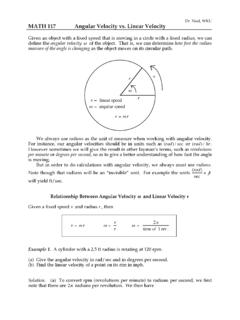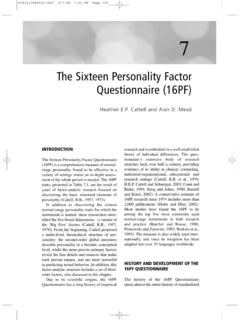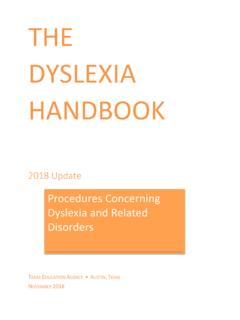Transcription of The Sixteen Personality Factor Questionnaire (16PF)
1 9781412946520-Ch07 5/7/08 7:03 PM Page 135. 7. The Sixteen Personality Factor Questionnaire (16PF). Heather Cattell and Alan D. Mead INTRODUCTION research and is embedded in a well-established theory of individual differences. This ques- The Sixteen Personality Factor Questionnaire tionnaire's extensive body of research (16PF) is a comprehensive measure of normal- stretches back over half a century, providing range Personality found to be effective in a evidence of its utility in clinical, counseling, variety of settings where an in-depth assess- industrial-organizational, educational, and ment of the whole person is needed.
2 The 16PF research settings (Cattell, et al., 1970;. traits, presented in Table , are the result of Cattell and Schuerger, 2003; Conn and years of Factor -analytic research focused on Rieke, 1994; Krug and Johns, 1990; Russell discovering the basic structural elements of and Karol, 2002). A conservative estimate of Personality (Cattell, , 1957, 1973). 16PF research since 1974 includes more than In addition to discovering the Sixteen 2,000 publications (Hofer and Eber, 2002). normal-range Personality traits for which the Most studies have found the 16PF to be instrument is named, these researchers iden- among the top five most commonly used tified the five broad dimensions a variant of normal-range instruments in both research the Big Five' factors (Cattell, , 1957, and practice (Butcher and Rouse, 1996.))
3 1970). From the beginning, Cattell proposed Piotrowski and Zalewski, 1993; Watkins et al., a multi-level, hierarchical structure of per- 1995). The measure is also widely used inter- sonality: the second-order global measures nationally, and since its inception has been describe Personality at a broader, conceptual adapted into over 35 languages worldwide. level, while the more precise primary factors reveal the fine details and nuances that make each person unique, and are more powerful in predicting actual behavior. In addition, this HISTORY AND DEVELOPMENT OF THE.
4 Factor -analytic structure includes a set of third- 16PF Questionnaire . order factors, also discussed in this chapter. Due to its scientific origins, the 16PF The history of the 16PF Questionnaire Questionnaire has a long history of empirical spans almost the entire history of standardized 9781412946520-Ch07 5/7/08 7:03 PM Page 136. 136 THE SAGE HANDBOOK OF Personality THEORY AND ASSESSMENT. Table 16PF Scale Names and Descriptors Descriptors of Low Range Primary Scales Descriptors of High Range Reserved, Impersonal, Distant Warmth (A) Warm-hearted, Caring, Attentive To Others Concrete, Lower Mental Capacity Reasoning (B) Abstract, Bright, Fast-Learner Reactive, Affected By Feelings Emotional Stability (C) Emotionally Stable, Adaptive, Mature Deferential, Cooperative, Avoids Conflict Dominance (E) Dominant, Forceful, Assertive Serious, Restrained, Careful Liveliness (F)
5 Enthusiastic, Animated, Spontaneous Expedient, Nonconforming Rule-Consciousness (G) Rule-Conscious, Dutiful Shy, Timid, Threat-Sensitive Social Boldness (H) Socially Bold, Venturesome, Thick-Skinned Tough, Objective, Unsentimental Sensitivity (I) Sensitive, Aesthetic, Tender-Minded Trusting, Unsuspecting, Accepting Vigilance (L) Vigilant, Suspicious, Skeptical, Wary Practical, Grounded, Down-To-Earth Abstractedness (M) Abstracted, Imaginative, Idea-Oriented Forthright, Genuine, Artless Privateness (N) Private, Discreet, Non-Disclosing Self-Assured, Unworried, Complacent Apprehension (O) Apprehensive, Self-Doubting, Worried Traditional, Attached To Familiar Openness to Change (Q1) Open To Change, Experimenting Group-Orientated, Affiliative Self-Reliance (Q2) Self-Reliant, Solitary, Individualistic Tolerates Disorder, Unexacting, Flexible Perfectionism (Q3) Perfectionistic, Organized, Self-Disciplined Relaxed, Placid, Patient Tension (Q4)
6 Tense, High Energy, Driven Global Scales Introverted, Socially Inhibited Extraversion Extraverted, Socially Participating Low Anxiety, Unperturbable Anxiety Neuroticism High Anxiety, Perturbable Receptive, Open-Minded, Intuitive Tough-Mindedness Tough-Minded, Resolute, Unempathic Accommodating, Agreeable, Selfless Independence Independent, Persuasive, Willful Unrestrained, Follows Urges Self-Control Self-Controlled, Inhibits Urges Adapted with permission from Conn and Rieke (1994). 16PF Fifth Edition Technical Manual. Champaign, IL: Institute for Personality and Ability Testing, Inc.
7 Personality measurement. Instead of being hydrogen and oxygen). For psychology to developed to measure preconceived dimen- advance as a science, he felt it also needed sions of interest to a particular author, the basic measurement techniques for Personality . instrument was developed from the unique Thus, through Factor analysis the powerful perspective of a scientific quest to try to new tool for identifying underlying dimen- discover the basic structural elements of sions behind complex phenomena Cattell Personality . believed the basic dimensions of Personality Raymond Cattell's Personality research could be discovered and then measured.
8 Was based on his strong background in the Over several decades, Cattell and his col- physical sciences; born in 1905, he witnessed leagues carried out a program of comprehen- the first-hand awe-inspiring results of sci- sive, international research seeking a ence, from electricity and telephones to auto- thorough, research-based map of normal per- mobiles, airplanes, and medicine. He wanted sonality. They systematically measured the to apply these scientific methods to the widest possible range of Personality dimen- uncharted domain of human Personality with sions, believing that all aspects of human the goal of discovering the basic elements of Personality which are or have been of impor- Personality (much as the basic elements of the tance, interest, or utility have already become physical world were discovered and organ- recorded in the substance of language'.)
9 Ized into the periodic table). He believed that (Cattell, , 1943: 483). They studied these human characteristics such as creativity, traits in diverse populations, using three differ- authoritarianism, altruism, or leadership skills ent methodologies (Cattell, , 1973): could be predicted from these fundamental observation of natural, in-situ life behavior or Personality traits (much as water was a L-data ( academic grades, number of traffic weighted combination of the elements of accidents, or social contacts); Questionnaire 9781412946520-Ch07 5/7/08 7:03 PM Page 137.
10 THE Sixteen Personality Factor Questionnaire (16PF) 137. or Q-data from the self-report domain; and research in each new country. Introduction of objective behavior measured in standardized, Web-based administration in 1999 allowed experimental settings or T-data ( number international test-users easy access to admin- of original solutions to problem presented, istration, scoring, and reports in many differ- responses to frustrations). Eventually, this ent languages, using local norms research resulted in the 16 unitary traits of the 16PF Questionnaire shown in Table From the beginning, Cattell's goal was to investigate universal aspects of Personality .






